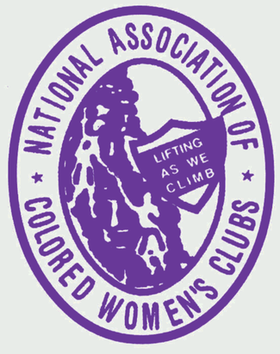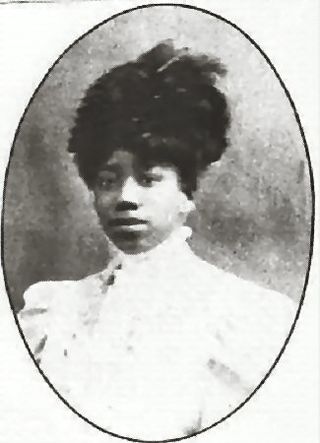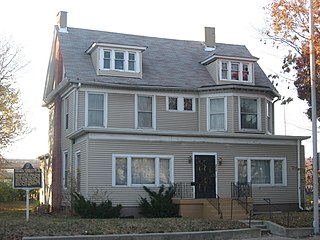Related Research Articles

Frances Elizabeth Caroline Willard was an American educator, temperance reformer, and women's suffragist. Willard became the national president of Woman's Christian Temperance Union (WCTU) in 1879 and remained president until her death in 1898. Her influence continued in the next decades, as the Eighteenth and Nineteenth Amendments to the United States Constitution were adopted. Willard developed the slogan "Do Everything" for the WCTU and encouraged members to engage in a broad array of social reforms by lobbying, petitioning, preaching, publishing, and education. During her lifetime, Willard succeeded in raising the age of consent in many states as well as passing labor reforms including the eight-hour work day. Her vision also encompassed prison reform, scientific temperance instruction, Christian socialism, and the global expansion of women's rights.

The National Association of Colored Women's Clubs (NACWC) is an American organization that was formed in July 1896 at the First Annual Convention of the National Federation of Afro-American Women in Washington, D.C., United States, by a merger of the National Federation of Afro-American Women, the Woman's Era Club of Boston, and the Colored Women's League of Washington, DC, at the call of Josephine St. Pierre Ruffin. From 1896 to 1904 it was known as the National Association of Colored Women (NACW). It adopted the motto "Lifting as we climb", to demonstrate to "an ignorant and suspicious world that our aims and interests are identical with those of all good aspiring women." When incorporated in 1904, NACW became known as the National Association of Colored Women's Clubs (NACWC).

The history of African Americans in Chicago or Black Chicagoans dates back to Jean Baptiste Point du Sable's trading activities in the 1780s. Du Sable, the city's founder, was Haitian of African and French descent. Fugitive slaves and freedmen established the city's first black community in the 1840s. By the late 19th century, the first black person had been elected to office.

The Alpha Suffrage Club was the first and most important black female suffrage club in Chicago and one of the most important in Illinois. It was founded on January 30, 1913, by Ida B. Wells with the help of her white colleagues Belle Squire and Virginia Brooks. The Club aimed to give a voice to African American women who had been excluded from national suffrage organizations such as the National American Women Suffrage Association (NAWSA). Its stated purpose was to inform black women of their civic responsibility and to organize them to help elect candidates who would best serve the interests of African Americans in Chicago.

The General Federation of Women's Clubs (GFWC), founded in 1890 during the Progressive Movement, is a federation of approximately 2,300 women's clubs in the United States which promote civic improvements through volunteer service. Community Service Projects (CSP) are organized by local clubs for the benefit of their communities or GFWC's Affiliate Organization (AO) partnerships. GFWC maintains nearly 60,000 members throughout the United States and internationally. GFWC is one of the world's largest and oldest nonpartisan, nondenominational, women's volunteer service organizations. The GFWC headquarters is located in Washington, D.C.

Jessie Daniel Ames was a suffragist and civil rights leader from Texas who helped create the anti-lynching movement in the American South. She was one of the first Southern white women to speak out and work publicly against lynching of African Americans, murders which white men claimed to commit in an effort to protect women's "virtue." Despite risks to her personal safety, Ames stood up to these men and led organized efforts by white women to protest lynchings. She gained 40,000 signatures of Southern white women to oppose lynching, helping change attitudes and bring about a decline in these murders in the 1930s and 1940s.
African-American women began to agitate for political rights in the 1830s, creating the Boston Female Anti-Slavery Society, Philadelphia Female Anti-Slavery Society, and New York Female Anti-Slavery Society. These interracial groups were radical expressions of women's political ideals, and they led directly to voting rights activism before and after the Civil War. Throughout the 19th century, African-American women such as Harriet Forten Purvis, Mary Ann Shadd Cary, and Frances Ellen Watkins Harper worked on two fronts simultaneously: reminding African-American men and white women that Black women needed legal rights, especially the right to vote.

Dr. Fannie Hagen Emanuel was an American medical doctor and civic leader active in Chicago over the early decades of the twentieth century. In 1908 she founded the Emanuel Settlement House in Chicago.

Elizabeth Lindsay Davis (1855-1944) was an African-American teacher and activist. She was responsible for forming the Phyllis Wheatley Women's Club in Chicago, Illinois in 1900. Over the course of her life, she participated and contributed to the advancement of African-American women. In 1922, she wrote The Story of the Illinois Federation of Colored Women's Clubs, a book highlighting the history of women's organizations and their notable members in the state of Illinois. In 1933, she published her book Lifting as They Climb about the history of the National Association of Colored Women. During her life, she collaborated with Ida B. Wells and W.E.B. DuBois to contribute to the progress and to support African-American women during the early 20th century.

Indiana State Federation of Colored Women's Clubs, also known as the Minor House, is a historic National Association of Colored Women's Clubs clubhouse in Indianapolis, Indiana. The two-and-one-half-story "T"-plan building was originally constructed in 1897 as a private dwelling for John and Sarah Minor; however, since 1927 it has served as the headquarters of the Indiana State Federation of Colored Women's Clubs, a nonprofit group of African American women. The Indiana federation was formally organized on April 27, 1904, in Indianapolis and incorporated in 1927. The group's Colonial Revival style frame building sits on a brick foundation and has a gable roof with hipped dormers. It was listed on the National Register of Historic Places in 1987.

The women's club movement was a social movement that took place throughout the United States that established the idea that women had a moral duty and responsibility to transform public policy. While women's organizations had existed earlier, it was not until the Progressive era (1896–1917) that they came to be considered a movement. The first wave of the club movement during the progressive era was started by white, middle-class, Protestant women, and a second phase was led by African-American women.

Joanna Snowden Porter was an American clubwoman based in Chicago; she was founder and president of the Northwestern Federation of Colored Women's Clubs.
The Frederick Douglass Woman's Club was formed in Chicago, Illinois, in 1906. It was one of the first women's clubs in Chicago to promote suffrage. It was notable because it was one of the few interracial women's clubs in Chicago.

The California State Federation of Colored Women's Clubs Inc. (CSACWC), was a woman's club formed in 1906 with the mission of serving the needs of California's African-American women and children.

Susan E. Cannon Allen was an African-American suffragist and temperance activist from Illinois. She served in numerous executive positions in several different women's clubs and was involved in club work at both the local and state level.

Sadie L. Adams was an African-American teacher, suffragist, and clubwoman. She was one of the first women to serve on an election board in Chicago and one of the founders of the Douglas League of Women Voters. In 1916, she served as a delegate from Chicago's first black suffrage organization, the Alpha Suffrage Club, to the National Equal Rights League conference. She was elected president of the Chicago and Northern District Association of Colored Women's Clubs in 1921, serving into 1934. She was also involved in various charity clubs and organizations that helped to engage women in war work during World War I, provide resources for underserved youth, and increase suffrage for Black women.

Mary Rice Phelps was an African-American teacher and writer. She began her teaching career at thirteen years old.

The Phillis Wheatley Clubs are women's clubs created by African Americans starting in the late 1800s. The first club was founded in Nashville, Tennessee, in 1895. Some clubs are still active. The purpose of Phillis Wheatley Clubs varied from area to area, although most were involved in community and personal improvement. Some clubs helped in desegregation and voting rights efforts. The clubs were named after the poet Phillis Wheatley.

Women's suffrage began in Illinois began in the mid-1850s. The first women's suffrage group was formed in Earlville, Illinois, by the cousin of Susan B. Anthony, Susan Hoxie Richardson. After the Civil War, former abolitionist Mary Livermore organized the Illinois Woman Suffrage Association (IWSA), which would later be renamed the Illinois Equal Suffrage Association (IESA). Frances Willard and other suffragists in the IESA worked to lobby various government entities for women's suffrage. In the 1870s, women were allowed to serve on school boards and were elected to that office. The first women to vote in Illinois were 15 women in Lombard, Illinois, led by Ellen A. Martin, who found a loophole in the law in 1891. Women were eventually allowed to vote for school offices in the 1890s. Women in Chicago and throughout Illinois fought for the right to vote based on the idea of no taxation without representation. They also continued to expand their efforts throughout the state. In 1913, women in Illinois were successful in gaining partial suffrage. They became the first women east of the Mississippi River to have the right to vote in presidential elections. Suffragists then worked to register women to vote. Both African-American and white suffragists registered women in huge numbers. In Chicago alone 200,000 women were registered to vote. After gaining partial suffrage, women in Illinois kept working towards full suffrage. The state became the first to ratify the Nineteenth Amendment, passing the ratification on June 10, 1919. The League of Women Voters (LWV) was announced in Chicago on February 14, 1920.
Viola Hill was an African-American suffragist, activist, and musician. She was a founding member of the Alpha Suffrage Club and a community leader within the African Methodist Episcopal Church.
References
- 1 2 3 Hendricks, Wanda A. (1998). Gender, Race, and Politics in the Midwest: Black Club Women in Illinois. Indiana University Press. ISBN 0253334470.
- 1 2 3 4 Leslie, LaVonne (2012). The History of the National Association of Colored Women'S Clubs, Inc.: A Legacy of Service. Xlibris Corporation. ISBN 9781479722655.
- ↑ Davis, Elizabeth Lindsay (1922). The Story of the Illinois Federation of Colored Women's Clubs. Chicago, Illinois. p. 80. OCLC 1013260810.
{{cite book}}: CS1 maint: location missing publisher (link) - ↑ Davis, Elizabeth Lindsay (1933). Lifting As They Climb . Washington, D. C.: National Association of Colored Women. p. 171. OCLC 1865680 – via ASP: Women and Social Movements.
- ↑ Knupfer, Anne M.; Silk, Leonard (1997). Toward a Tenderer Humanity and a Nobler Womanhood: African American Women's Clubs in Turn-Of-The-Century Chicago. NYU Press. ISBN 9780814748541.